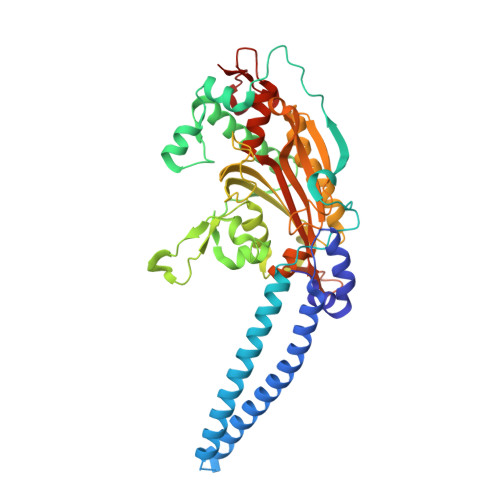Acylated sulfonamide adenosines as potent inhibitors of the adenylate-forming enzyme superfamily.
De Ruysscher, D., Pang, L., De Graef, S., Nautiyal, M., De Borggraeve, W.M., Rozenski, J., Strelkov, S.V., Weeks, S.D., Van Aerschot, A.(2019) Eur J Med Chem 174: 252-264
- PubMed: 31048140
- DOI: https://doi.org/10.1016/j.ejmech.2019.04.045
- Primary Citation of Related Structures:
6H9X - PubMed Abstract:
The superfamily of adenylate-forming enzymes all share a common chemistry. They activate a carboxylate group, on a specific substrate, by catalyzing the formation of a high energy mixed phosphoanhydride-linked nucleoside intermediate. Members of this diverse enzymatic family play key roles in a variety of metabolic pathways and therefore many have been regarded as drug targets. A generic approach to inhibit such enzymes is the use of non-hydrolysable sulfur-based bioisosteres of the adenylate intermediate. Here we compare the activity of compounds containing a sulfamoyl and sulfonamide linker respectively. An improved synthetic strategy was developed to generate inhibitors containing the latter that target isoleucyl- (IleRS) and seryl-tRNA synthetase (SerRS), two structurally distinct representatives of Class I and II aminoacyl-tRNA synthetases (aaRSs). These enzymes attach their respective amino acid to its cognate tRNA and are indispensable for protein translation. Evaluation of the ability of the two similar isosteres to inhibit serRS revealed a remarkable difference, with an almost complete loss of activity for seryl-sulfonamide 15 (SerSoHA) compared to its sulfamoyl analogue (SerSA), while inhibition of IleRS was unaffected. To explain these observations, we have determined a 2.1 Å crystal structure of Klebsiella pneumoniae SerRS in complex with SerSA. Using this structure as a template, modelling of 15 in the active site predicts an unfavourable eclipsed conformation. We extended the same modelling strategy to representative members of the whole adenylate-forming enzyme superfamily, and were able to disclose a new classification system for adenylating enzymes, based on their protein fold. The results suggest that, other than for the structural and functional orthologues of the Class II aaRSs, the O to C substitution within the sulfur-sugar link should generally preserve the inhibitory potency.
Organizational Affiliation:
KU Leuven, Rega Institute for Medical Research, Medicinal Chemistry, Herestraat 49 BOX 1030, 3000 Leuven, Belgium.

















